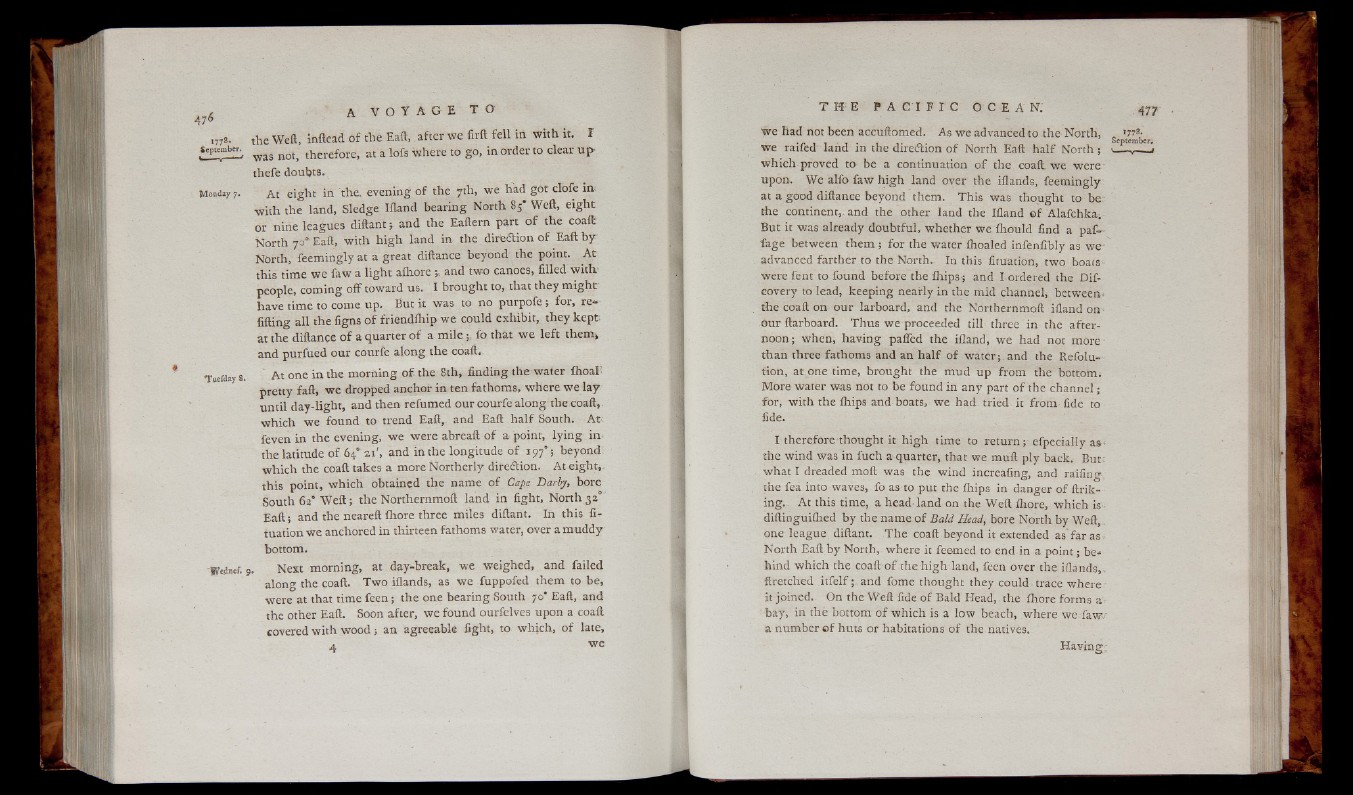
the Weft, inftead o f the Eaft, after we firft fe ll in w ith it, I
was not, therefore, at a lofs where to go, in order to clear up-
thefe doubts.
At e igh t in the. evening o f the 7th, w e had g o t clofe in;
w ith the land, Sledge Ifland bearing North 85* Weft, e igh t
or nine leagues diftant; and the Eaftern part o f the coaft
North 70“ Eaft, with h ig h land in the direction o f Eaft b y
North, feemingly at a great diftance beyond the point. A t
this time we faw a ligh t aihore ; and two canoes, filled with.'
people, coming o ff toward us. I brought to, that they m ig h t
have time to come up. But it was to no p u rp o fe ; for, re*-
fifting all the figns o f friendihip w e could exhibit, they k e p t
at the diftance o f a quarter o f a m i le ;, fo that w e le ft them,
and purfued our courfe along the coaft.
At one in the morning o f the 8th, finding the water IhoaL
pretty faft, w e dropped anchor in ten fathoms, where we la y
until day-light, and then refumed our courfe along the coaft,.
w hich we found to trend Eaft,. and Eaft h a lf South. A t
feven in the evening, we were abreaft o f a point, ly in g in
the latitude o f 64° 21', and in the longitude o f 197’ ; beyond
w h ich the coaft takes a more Northerly direction. At eight,,
this point, w hich obtained the name o f Cape Darby, bore
South 62’ Weft ; the Northernmoft land in fight, North 32*
E a ft; and the neareft ihore three miles diftant. In this fi-
tuation we anchored in thirteen fathoms water, over a muddy
bottom.
Next morning, at day-break, we weighed, and failed
along the coaft. Tw o iflands, as w e fuppofed them to be,
were at that time fe e n ; the one bearing South 70* Eaft, and
the other Eaft. Soon after, we found ourfelves upon a coaft
c o v e r e d with w o o d ; an agreeable fight, to which, o f late,
4 we
We Had not been accuftomed. As we advanced to the North, „ >77*-
• . September/.
we railed land in the dire&ion o f North Eaft h a lf N o rth ; i— -j
w hich proved to be a continuation o f the coaft. we were
upon, We alfo faw h ig h land over the iflands, feemingly
at a good diftance beyond them. This was thought to be
the continent, and the other land the Ifland ©f Alafchka.
But it was already doubtful, whether we Ihould find a paf—
fa g e between them ; fo r the water fhoaled infenfibly as w e
advanced farther to the North. In this fituation, two boats
were fent to found before the ihips-; and bordered the Dif-
eovery to lead, keeping nearly in the mid channel, between-
the coaft on our larboard, and the Northernmoft ifland on
our ftarboard. Thus we proceeded till three in the a fternoon
; when, ha vin g pafled the ifland, we had not more
than three fathoms and an h a lf o f water; and the Refolu-
fion, at one time, brought the mud up from the bottom.
More water was not to be found in any part o f the ch an n e l;
for, with the ihips and boats, we had- tried it from fide to
fide.
I therefore thought it h igh time to re turn ; efpecially as-
the wind was in fuch a quarter, that we muft ply back. But:
what I dreaded moft was the wind increafing, and railing
the fea into waves, fo as to put the Ihips in danger o f ftrik-
ing. At this time, a head land on the Weft ihore,. which is;
diftinguiihed by the name o f Bald Head, bore North by W e ft,.
one league diftant. T he coaft beyond it extended as’ far as
North Eaft b y North, where it feetned to end in a p o in t; behind
which the coaft o f the h igh land, feen oyer the iflands,-
ftretched i t f e l f ;. and fome thought they could trace where r
it joined. On the Weft fide o f Bald Head,. the ihore forms a.-
bay, in the bottom o f which is a low beach, where we.faw/
a number o f huts or habitations o f the natives.
H a v in g ;